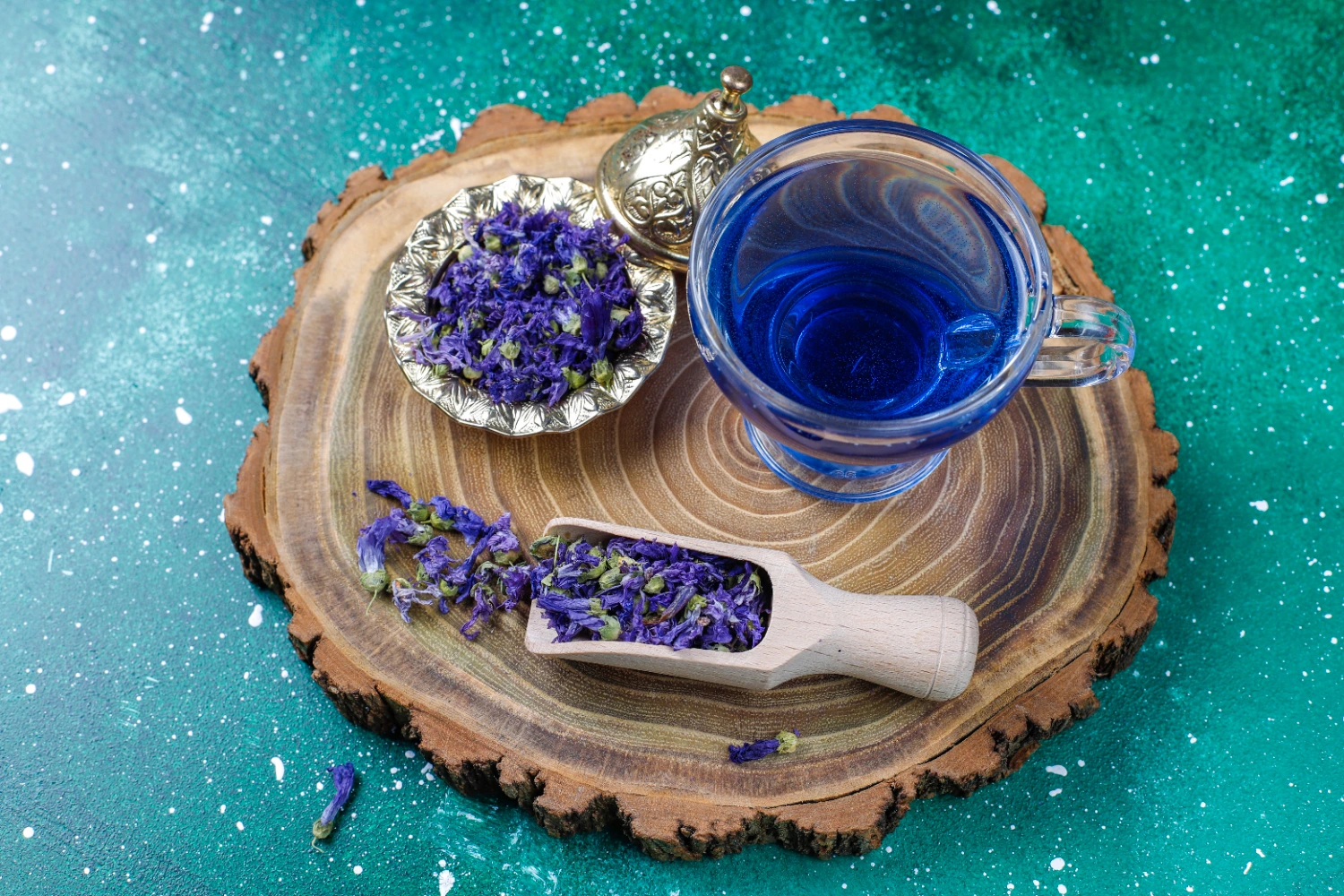Introduction
A Vibrant Blue Infusion
Butterfly pea tea is a visually enchanting herbal infusion known for its brilliant sapphire hue and subtle flavor profile. In fact, many people wonder, “What does butterfly pea tea taste like?” In short, this beverage offers a gentle blend of mild earthiness, delicate floral notes, and a whisper of natural sweetness. Above all, it provides a calming, sensory experience that is both soothing and intriguing. In addition, as global interest in unique teas grows, butterfly pea tea has emerged as a must-try infusion.
Not only that, this tea’s reputation stretches far beyond its mesmerizing color. Because of this, it has earned a place among the world’s most captivating herbal beverages. For more information on the general wellness aspects of herbal teas, consider exploring our guide on Health Benefits of Herbal Teas. Moreover, by understanding its taste and origins, you can appreciate why butterfly pea tea is becoming a household name.
What Does Butterfly Pea Tea Taste Like?
In fact, describing the flavor profile of this bright blue infusion can be as enchanting as the tea’s appearance. For instance, many enthusiasts note its subtle earthiness, reminiscent of mild green tea without the bitterness. Moreover, it carries delicate floral undertones that whisper hints of chamomile, creating a gentle, soothing sensation. As a result, the overall taste is pleasantly smooth, allowing it to pair well with sweeteners or other ingredients. Similarly, adding a squeeze of lemon juice not only introduces a tangy twist but also sparks a magical color transformation.
Not only that, its mild taste makes it adaptable to various recipes, from simple iced brews to more complex lattes or cocktails. If you’re curious about how to enhance and experiment with this infusion, take a look at our tips on Creative Tea Latte Recipes for inspiration. Above all, the gentle flavor of this tea leaves room for you to explore, adjust, and create a personalized beverage experience that’s entirely your own.
Understanding Butterfly Pea Tea
What Is Butterfly Pea Tea?
For instance, butterfly pea tea is made from the dried petals of the Clitoria ternatea flower, a plant native to Southeast Asia. On the other hand, unlike green or black teas, it contains no caffeine. As a result, this infusion is perfect for those seeking a soothing evening drink. In contrast to many other herbal teas, butterfly pea tea is valued not only for its flavor but also for its stunning appearance. In fact, when steeped, it reveals a vibrant blue hue that can shift to purple when combined with acidic ingredients like lemon juice.
Additionally, this tea’s versatility makes it a delightful base for creative culinary endeavors. In addition, you can use it as a natural food coloring agent in desserts or beverages. For those curious about perfecting the brewing process, you can learn more in our article on How to Brew the Perfect Cup of Tea. Therefore, having a solid understanding of butterfly pea tea’s characteristics will set you up for success when experimenting in the kitchen.
Flavor Profile: What Does Butterfly Pea Tea Taste Like?
Delicate, Earthy, and Floral Notes
In short, butterfly pea tea’s taste is subtle yet distinctive. For example, when brewed, it imparts a gentle earthiness, reminiscent of mild green tea but without the bitterness. Moreover, it offers floral undertones similar to chamomile, though more subdued. As a result, the flavor never overwhelms your palate. In addition, a delicate hint of sweetness lingers, especially if enhanced with a natural sweetener like honey.
Not only that, this mild flavor profile makes butterfly pea tea an ideal candidate for mixing with other ingredients. For instance, add a bit of lemon juice, and the tea’s color will shift beautifully while introducing a tangy note. Similarly, blending it with mint leaves or coconut water can result in refreshing iced beverages perfect for warm weather. Consequently, the adaptability of butterfly pea tea encourages endless experimentation.
If you’re intrigued by other ways to enhance teas, consider our post on Creative Tea Latte Recipes. Because of this, you can discover new methods to elevate both the flavor and presentation of your drinks.
How to Brew Butterfly Pea Tea Perfectly
Ingredients and Preparation
Next, gather your ingredients:
- 1 teaspoon dried butterfly pea flowers (or a butterfly pea tea bag)
- 1 cup hot water (around 90°C/194°F)
- Honey, sugar, or lemon juice (optional)
After that, follow these steps:
- For example, measure about 1 teaspoon of dried butterfly pea flowers and place them into a teapot or infuser.
- In addition, heat your water gently, avoiding a full boil, to preserve the tea’s delicate qualities.
- Not only that, once the water is ready, pour it over the flowers and steep for 5-7 minutes. In fact, watch the water gradually transform into a brilliant blue shade.
- On the other hand, if you prefer a sweeter taste, stir in honey or sugar. Similarly, a squeeze of lemon juice will not only add brightness but also cause a color change.
- Finally, strain the tea and serve hot or over ice. In conclusion, you now have the perfect base for countless butterfly pea tea variations.
For more ideas on natural hues, you may want to read about Homemade Natural Food Coloring Ideas, as a result gaining inspiration for colorful culinary creations.
Creative Tips for Enjoying Butterfly Pea Tea
Color-Changing Magic
For instance, adding lemon or lime juice can shift your tea from blue to purple, delighting guests and children alike.
Iced Butterfly Pea Tea
Moreover, serve the tea over ice with mint leaves or coconut water. In fact, it creates a refreshing summer drink that’s both visually appealing and hydrating.
Butterfly Pea Latte
In contrast to traditional tea lattes, try blending your butterfly pea infusion with steamed milk—dairy or plant-based—and a touch of vanilla syrup. Because of this, you’ll achieve a creamy, pastel beverage that impresses both the eyes and taste buds.
Cocktail Ingredient
On the other hand, butterfly pea tea also works as a stunning cocktail ingredient. Similarly, use it to create vibrantly colored cocktails, from mojitos to margaritas, enchanting your guests at gatherings. If you’re interested in preserving ingredients for future use, explore How to Store Dried Herbs and Flowers.
Consequently, these creative serving suggestions ensure you never run out of unique ways to enjoy butterfly pea tea.
Health Benefits of Butterfly Pea Tea
Nutritional and Wellness Advantages
In fact, butterfly pea tea is rich in antioxidants, which help combat oxidative stress. As a result, it may support overall wellness. Not only that, traditional Ayurvedic practices connect butterfly pea flowers to improved memory and reduced anxiety. More importantly, anthocyanins in the tea could enhance skin elasticity and promote healthy hair growth.
Additionally, many herbal beverages can complement a balanced lifestyle. Because of this, regularly enjoying butterfly pea tea may be both a delightful and beneficial choice. To learn more about enhancing your overall wellness routine, consider checking out additional resources like our Post Sitemap to find more intriguing content.
People Also Ask
What does butterfly pea flower tea taste like?
Mildly earthy and floral with a subtle sweetness. In short, it’s pleasant and gentle.
What is butterfly pea tea?
A caffeine-free infusion made from dried butterfly pea petals. For example, it’s known for its vivid blue color and health benefits.
Does butterfly pea tea have caffeine?
No, it’s naturally caffeine-free. In addition, it’s perfect for nighttime relaxation.
Culinary Traditions and Modern Applications
In fact, this vividly hued infusion has long held a place in Southeast Asian culinary traditions, where it enriches drinks, sweets, and savory dishes alike. Moreover, its ability to impart natural coloration without the need for artificial dyes has positioned it as a sought-after ingredient among chefs and home cooks. On the other hand, as global culinary trends continue to spotlight plant-based and wellness-focused ingredients, its popularity steadily expands beyond its regions of origin. In addition, the subtlety of its flavor allows it to blend seamlessly into a broad range of recipes, from artisanal cocktails and gourmet desserts to vibrant smoothie bowls.
For instance, a combination of this herbal beverage with coconut milk creates a visually striking and creamy treat, while incorporating it into rice dishes can result in a beautifully tinted plate that excites the senses. Not only that, many contemporary bartenders and mixologists have embraced it as a way to astonish patrons, crafting cocktails that shift from one color to another simply by adding a splash of citrus. Because of this, food enthusiasts and culinary innovators continue to experiment, discovering new and unexpected ways to incorporate this remarkable infusion into their creations.
As a result, its multifaceted nature ensures that no two culinary experiences are the same, encouraging continuous exploration. In conclusion, whether incorporated into time-honored recipes or used to inspire novel gastronomic inventions, this naturally colorful infusion stands as a testament to the boundless creativity found in modern cuisine.
Sustainability and Ethical Sourcing
In fact, as consumers grow more conscious of where their ingredients originate, paying attention to sustainable and ethical sourcing has become paramount. Moreover, many purveyors of this vividly hued herbal infusion are increasingly focused on fair-trade practices and environmentally responsible cultivation methods. On the other hand, by selecting teas that prioritize small-scale farmers and minimize the ecological footprint, you contribute to a healthier planet and fairer marketplace.
In addition, responsibly sourced petals not only ensure you’re enjoying a high-quality product but also support communities that rely on these crops for their livelihood. For instance, look for certifications and credible supplier information, indicating that your purchase aligns with eco-friendly practices. Not only that, by doing so, you encourage sustainable agriculture that preserves biodiversity, reduces chemical usage, and safeguards the well-being of future generations.
As a result, the mindful approach to sourcing and sustainability fosters an environment in which everyone benefits—from the farmers to the end consumers. In conclusion, making informed choices about the origin and cultivation of your ingredients allows you to savor each sip with confidence, knowing you’ve supported ethical and earth-friendly production methods.
FAQs
Is butterfly pea tea safe for everyone?
Generally, yes. However, pregnant or breastfeeding women should consult a healthcare professional before trying new herbal teas.
Can I drink butterfly pea tea every day?
In fact, moderate daily consumption is safe. Therefore, enjoy it as part of a balanced lifestyle.
How does butterfly pea tea change color?
The anthocyanins react to acidic ingredients like lemon juice. Consequently, the tea shifts from blue to purple.
Can butterfly pea tea be used in desserts?
Absolutely! For instance, use it as a natural colorant in cakes, jellies, and puddings.
What are the storage tips for butterfly pea tea?
Keep dried petals in an airtight container away from moisture. Because of this, they remain fresh longer. Also, explore our tips in How to Store Dried Herbs and Flowers.
Where can I buy butterfly pea tea?
You can find it online, at health food stores, or specialty tea shops. After that, experiment with different brands to find your favorite .
Conclusion
In conclusion, the enchanting allure of butterfly pea tea lies not only in its mesmerizing color changes and mild, floral flavor but also in its growing availability through sustainable and ethically sourced channels. In fact, by choosing responsibly produced butterfly pea tea, you support communities, preserve ecosystems, and enjoy a beverage that resonates with cultural history and modern innovation. As a result, savoring a cup of butterfly pea tea can become an act of mindful consumption, bridging the gap between tradition and progress. Finally, integrating butterfly pea tea into your daily routine offers both sensory delight and the satisfaction of making an informed, eco-conscious choice. For further inspiration, consider exploring recipes and preparation tips from sources like Tasty, Allrecipes, and Delish, where you can discover creative ways to enjoy your butterfly pea tea.

